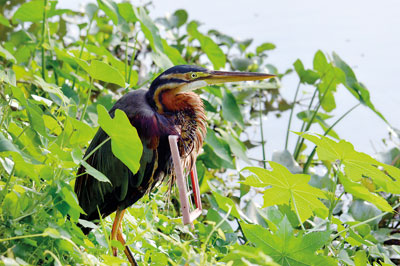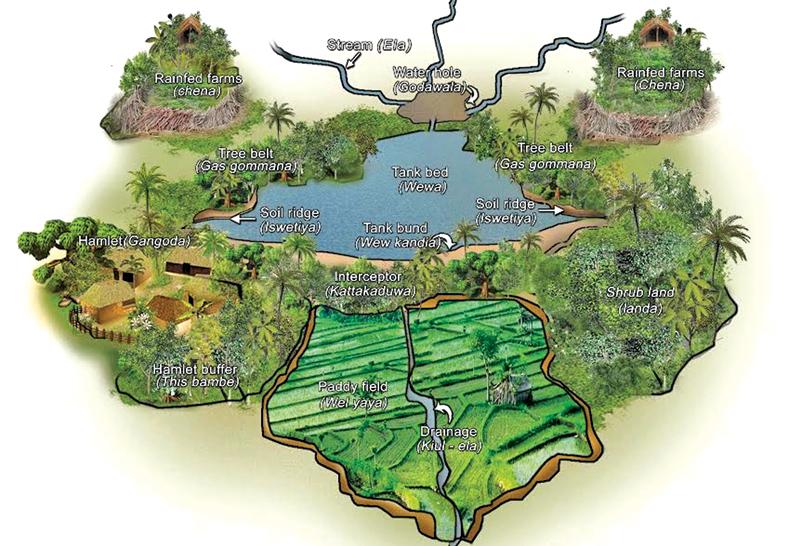
Don’t trash nature’s gifts, wildlife experts plead
(Birds; victims of careless garbage dumping by us humans. Pix by Sumith Bandara)
Reckless disposal of garbage in our localities can put precious bird life in peril as two recent incidents showed.Wildlife specialists are appealing to Sri Lankans to be a lot more considerate after rescuing two species of bird that endured the horrors of human encroachment of their habitat.
Herpetologist and wildlife photographer Mendis Wickramasinghe and two assistants Sumith Bandara and Saman waited until dusk last Sunday to go to the aid of a purple heron (karawal koka), which often feeds on fish in marshes and paddy fields, struggling to free its beak tangled in a plastic contraption.
Photos of its plight at Boralasgamuwa tank, caught the attention of social media users and drew the usual chatter.
Wickramasinghe and his aides freed the blue heron from its misery. They then checked for possible wounds and released the bird. The following morning they visited the location to give it a meal of fish, but the blue heron had other ideas and flew off to feed itself.Bandara said it was a happy outcome, but he pleaded with Sri Lankans to abandon destructive habits. “People need to be more careful when dumping waste,” he said.
But then two days later, he had to rescue another bird from similar circumstances.Being a keen wildlife photographer, Bandara again visited the Boralasgamuwa tank on Wednesday evening. He soon saw a yellow bittern (kaha metikoka) with its beak entangled in a net. Bandara noticed it was a discarded mosquito net.
As dusk approached Bandara and friend Amila Ranga waded into deep water and released the bird from the net. It was a risky exercise. The exhausted bird appeared disoriented and stood by for a few minutes before taking flight.Bandara also noted that strings used for kite flying have also become death traps for birds.
Source : Sunday Times http://www.sundaytimes.lk/161211/news/dont-trash-natures-gifts-wildlife-experts-plead-219744.html

FAO, EU Help Develop Tank Ecosystem in Podiwewa
The environs of the Podiwewa, a minor irrigation tank in Moneragala was a hive of activity recently as the villagers from Thimbirigas-ara in Buttala joined the Moneragala District Secretary, D.S. Pathma Kulasooriya and officials of the Department of Agrarian Development to plant saplings around the Podiwewa to develop the tank ecosystem.
The Podiwewa is intertwined with the lives of 43 farmer families in Thimbirigas-ara as it irrigates paddy farms and other field crop cultivations while also providing a water source for daily needs.
Supported by the Food and Agriculture Organization of the United Nations (FAO) and the European Union, saplings such as kumbuk, tamarind, mee and karanda were planted on the upstream section of the tank. palmyrah saplings were planted along the downstream edge of the tank bund.
The saplings were provided by our villagers and the Forest Department,” said Gunadasa, the President of the Thimbirigas-ara Farmers Organization. “We planted around 600 saplings in a one kilometre area. Each farmer has now taken on the responsibility of nurturing around 10-15 of these plants.”
The saplings that were planted in the upstream section of the tank (gas gommana) will eventually become natural wind barriers during high winds, reduce evaporation and erosion, and will protect the tank from illegal encroachments.
In Sri Lanka, the ecological segments of the village tank system play vital roles. The downstream reservation (Kattakaduwa) is the stretch between the tank bund and paddy fields.
It contains flora which acts as a downstream wind barrier, minimizes seepage and prevents polluted water containing salt and heavy metals from flowing into paddy fields.
The soil ridge (iswetiya) of the tank diverts sediments/silt, thereby preventing soil erosion.
The waterhole (godawala) in the tank inlets act as a source of drinking water for wildlife and livestock while trapping the sediments, which would otherwise flow into the tank.
However, most of the ecological components of village tanks that have existed for centuries are disappearing. Encroachment for cultivation purposes and removal of trees for various uses are some of the main reasons. The cause stems from a lack of awareness on the importance of the tank ecosystem. FAO Technical Officer (Moneragala District), Ranjith Pushpananda said, “developing the ecosystem of irrigation tanks is crucial as tanks mitigate the effects of natural disasters such as drought and floods.”
“For instance, the storage of excessive runoff water in tanks during heavy rains reduces flooding and conserves water for use in the dry season. Irrigation tanks also enhance biodiversity. The importance of the tank ecosystem was shared with the villagers of Thimbirigas-ara.
The villagers constructed the soil ridge of the tank and the waterhole prior to the tree planting initiative,” he said. Gunadasa said, “We became aware of how the environment helps us and the importance of protecting the tank and its surroundings.
At a time when trees are being cut down and forests are being cleared, planting saplings on the tank bed of the Podiwewa is an example to villagers that depend on tanks. The future generation of Buttala will greatly benefit from it.” The Podiwewa is being rehabilitated by FAO under the European Union Support to District Development Programe (EU-SDDP) which has a total financial envelope of EUR 60 million. Improvements to the irrigation channel and spillway of the Podiwewa, widening of the tank bund and improving the access road to the tank are ongoing. Once rehabilitation works are completed, the farmers of Thimbirigas-ara will conduct regular ordinary maintenance of the tank and will continue to conserve the tank ecosystem.
Source : 18/12/2016 Sunday Observer http://www.sundayobserver.lk/2016/12/18/business/fao-eu-help-develop-tank-ecosystem-podiwewa







